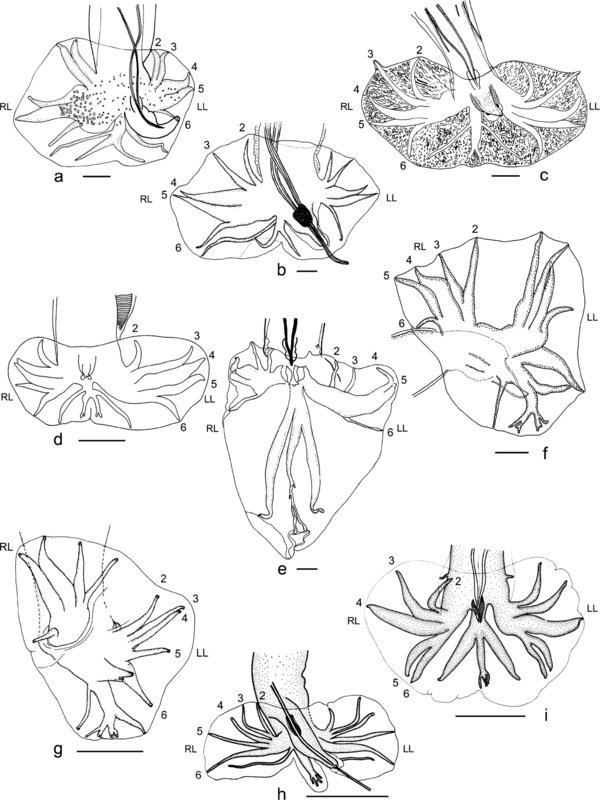Fig. 4

Download original image
Figs. 4a–d
Variations on types 2-2-1, 1-3-1 and 1-4. Scale-bars: 50 μm.
a. Type 2-2-1 with rays 2 and 3 apposed for much of their length. Ex: Stilestrongylus freitasi Durette-Desset, 1968a. After Durette- Desset (1968a), modified.
b. Type 2-2-1 with rays 2 and 3 grouped from the base in a narrow V-shape. Ex: right lobe of Stilestrongylus andalgala Digiani & Durette-Desset, 2007. After Digiani & Durette-Desset (2007), modified.
c. Type 2-2-1 with rays 2 and 3 grouped from the base in a wide V-shape. Ex: Carolinensis kinsellai (Durette-Desset, 1969). After Durette-Desset (1969), modified.
d. Type 1-3-1 with rays 3 diverging distally to rays 5 from the common trunk of rays 3 to 5. Ex: right lobe of Heligmonina wakelini Durette-Desset, Digiani, Mahlaba & Behnké, 2007. After Durette- Desset et al. (2007), modified.
Figs. 4e–i
Atypical patterns. Scale-bars: 50 μm.
e. Type 1-1-2-1. Rays 2 arise first from the common trunk of rays 2 to 6; rays 3 are completely separated and parallel to rays 2 and arise at the same level as rays 6; rays 4 and 5 are the last to diverge. Ex: left lobe of Cordicauda cordicauda (Durette-Desset, 1966). After Durette-Desset (1966), modified.
f. Type 1-3-1 t 4-1. Ray 6 arises first from the common trunk of rays 2 to 6; ray 2 arises just distally to the level of divergence of ray 6 and rays 2 to 5 have a short common trunk. Ex: right lobe of Nippostrongylus magnus (Mawson, 1961). Type 4-1. Ray 6 arises first from the common trunk of rays 2 to 6 and rays 2 to 5 have a long common trunk. Ex: left lobe of N. magnus. After Beveridge & Durette-Desset (1992), modified.
g. Type 3-1-1. Rays 5 and 6 arise first but separately from the common trunk of rays 2 to 6 and rays 2 to 4 have a long common trunk. Ex: left lobe of Nippostrongylus marhaeniae Hasegawa & Syafruddin, 1995. The right lobe shows a pattern of type 1-3-1 t 4-1. After Hasegawa & Syafruddin (1995), modified.
h. Type 1-2-1-1. Ray 2 arises first from the common trunk of rays 2 to 6; rays 3 and 4 are grouped and rays 5 and 6 arise separately and at the same level as the group formed by rays 3 and 4. Ex: left lobe of Sciuricola moreli (Gibbons, Durette-Desset & Daynes, 1977). The right lobe shows a pattern of type 2-2-1. After Durette- Desset (1974), modified.
i. Type 1-2-2. Ray 2 arises first from the common trunk of rays 2 to 6; rays 3 and 4 are grouped; rays 5 and 6 have a short common trunk and arise at the same level as ray 2 and the group formed by rays 3 and 4. Ex: right lobe of Trichoslinstowia maseri Durette- Desset & Vaucher, 1974. After Durette-Desset & Vaucher (1974), modified. Type 2-1-2. Rays 2 and 3 are grouped and arise first from the common trunk of rays 2 to 6; ray 4 is isolated; rays 5 and 6 have a short common trunk and arise at the same level as ray 4 and the group formed by rays 2 and 3. Ex: left lobe of T. maseri. After Durette-Desset & Vaucher (1974), modified.
Current usage metrics show cumulative count of Article Views (full-text article views including HTML views, PDF and ePub downloads, according to the available data) and Abstracts Views on Vision4Press platform.
Data correspond to usage on the plateform after 2015. The current usage metrics is available 48-96 hours after online publication and is updated daily on week days.
Initial download of the metrics may take a while.


